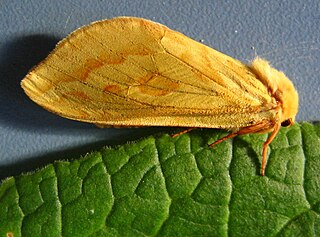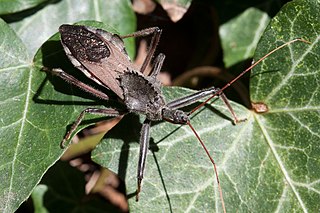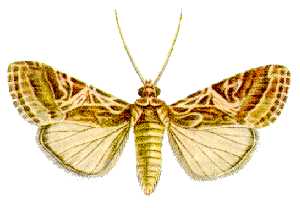
The Hemiptera or true bugs are an order of insects comprising some 50,000 to 80,000 species of groups such as the cicadas, aphids, planthoppers, leafhoppers, bed bugs and shield bugs. They range in size from 1 mm (0.04 in) to around 15 cm (6 in), and share a common arrangement of sucking mouthparts. The name "true bugs" is often limited to the suborder Heteroptera. Many insects commonly known as "bugs", especially in American English, belong to other orders; for example, the lovebug is a fly and the May bug and ladybug are beetles.

Helicoverpa zea, commonly known as the corn earworm, is a species in the family Noctuidae. The larva of the moth Helicoverpa zea is a major agricultural pest. Since it is polyphagous during the larval stage, the species has been given many different common names, including the cotton bollworm and the tomato fruitworm. It also consumes a wide variety of other crops.

The Reduviidae are a large cosmopolitan family of the order Hemiptera. Among the Hemiptera and together with the Nabidae almost all species are terrestrial ambush predators: most other predatory Hemiptera are aquatic. The main examples of nonpredatory Reduviidae are some blood-sucking ectoparasites in the subfamily Triatominae. Though spectacular exceptions are known, most members of the family are fairly easily recognizable; they have a relatively narrow neck, sturdy build, and formidable curved proboscis. Large specimens should be handled with caution, if at all, because they sometimes defend themselves with a very painful stab from the proboscis.

The ghost moth or ghost swift is a moth of the family Hepialidae. It is common throughout Europe, except for in the far south-east.

The wheel bug is a species of large assassin bug in the family Reduviidae. The species is one of the largest terrestrial true bugs in North America, reaching up to 1.5 inches (38 mm) in length in their adult stage. They are sexually dimorphic, in that males are somewhat smaller than the females. A characteristic structure is the wheel-shaped pronotal armor. Wheel bugs prey on caterpillars and beetles, such as Japanese beetles, the cabbage worm, orange dogs, tent caterpillars, and the Mexican bean beetle, all of which they pierce with their beak to inject salivary fluids that dissolve soft tissue. Wheel bugs are most active in daylight, though they may engage in predatory behaviors at night in areas illuminated by lights. Because most of their prey are pests, wheel bugs are considered beneficial.
In agriculture and gardening, a beneficial organism is any organism that benefits the growing process, including insects, arachnids, other animals, plants, bacteria, fungi, viruses, and nematodes. Benefits include pest control, pollination, and maintenance of soil health. The opposite of beneficial organisms are pests, which are organisms deemed detrimental to the growing process. There are many different types of beneficial organisms as well as beneficial microorganisms. Also, microorganisms have things like salt and sugar in them. Beneficial organisms include but are not limited to: Birds, Bears, Nematodes, Insects, Arachnids, and fungi. The ways that birds and bears are considered beneficial is mainly because they consume seeds from plant and spread them through feces. Birds also prey on certain insects that eat plants and hinder them from growing these insects are known as non beneficial organisms. Nematodes are considered beneficial because they will help compost and provide nutrients for the soil the plants are growing in. Insects and arachnids help the growing process because they prey on non beneficial organisms that consume plants for food. Fungi help the growing process by using long threads of mycelium that can reach very long distances away from the tree or plant and bring water and nutrients back to the tree or plant roots.

The Asilidae are the robber fly family, also called assassin flies. They are powerfully built, bristly flies with a short, stout proboscis enclosing the sharp, sucking hypopharynx. The name "robber flies" reflects their notoriously aggressive predatory habits; they feed mainly or exclusively on other insects and as a rule they wait in ambush and catch their prey in flight.

Insect mandibles are a pair of appendages near the insect’s mouth, and the most anterior of the three pairs of oral appendages. Their function is typically to grasp, crush, or cut the insect’s food, or to defend against predators or rivals. Insect mandibles, which appear to be evolutionarily derived from legs, move in the horizontal plane unlike those of vertebrates, which appear to be derived from gill arches and move vertically.

The spined soldier bug is a species of insect common in North America. They are predators of gypsy moth caterpillars and the larvae of beetles such as the Colorado potato beetle and the Mexican bean beetle. Since the Mexican bean beetle is widely regarded as a notorious agricultural pest in North America, soldier bugs are generally considered useful garden insects.

Spodoptera litura, otherwise known as the tobacco cutworm or cotton leafworm, is a nocturnal moth in the family Noctuidae. S. litura is a serious polyphagous pest in Asia, Oceania, and the Indian subcontinent that was first described by Johan Christian Fabricius in 1775. Its common names reference two of the most frequent host plants of the moth. In total, 87 species of host plants that are infested by S. litura are of economic importance. The species parasitize the plants through the larvae vigorous eating patterns, oftentimes leaving the leaves completely destroyed. The moth's effects are quite disastrous, destroying economically important agricultural crops and decreasing yield in some plants completely. Their potential impact on the many different cultivated crops, and subsequently the local agricultural economy, has led to serious efforts to control the pests.

Insects have a range of mouthparts, adapted to particular modes of feeding. The earliest insects had chewing mouthparts. Specialization has mostly been for piercing and sucking, although a range of specializations exist, as these modes of feeding have evolved a number of times (for example, mosquitoes and aphids both pierce and suck, however female mosquitoes feed on animal blood whereas aphids feed on plant fluids. In this page, the individual mouthparts are introduced for chewing insects. Specializations are generally described thereafter.

Insect toxins are various protein toxins produced by insect species.

Coccinellidae is a widespread family of small beetles ranging in size from 0.8 to 18 mm. The family is commonly known as ladybugs in North America and ladybirds in Britain and other parts of the English-speaking world. Entomologists prefer the names ladybird beetles or lady beetles as these insects are not classified as true bugs.

Rhynocoris is a genus of assassin bug, family (Reduviidae), in the subfamily Harpactorinae. Species are recorded from Asia, mainland Europe, Africa and North America.

Zelus renardii, the leaf hopper assassin bug, is a predacious insect contained within tribe Harpactorini. Diurnal and found on both wild and crop plants, Z. renardii has spread from its native habitats in western North and Central America into three other biogeographic regions across the globe.

Chrysoperla carnea, known as the common green lacewing, is an insect in the Chrysopidae family. Although the adults feed on nectar, pollen and aphid honeydew, the larvae are active predators and feed on aphids and other small insects. It has been used in the biological control of insect pests on crops.

Ostrinia furnacalis is a species of moth in the family Crambidae, the grass moths. It was described by Achille Guenée in 1854 and is known by the common name Asian corn borer since this species is found in Asia and feeds mainly on corn crop. The moth is found from China to Australia, including in Java, Sulawesi, the Philippines, Borneo, New Guinea, the Solomon Islands, and Micronesia. The Asian corn borer is part of the species complex, Ostrinia, in which members are difficult to distinguish based on appearance. Other Ostrinia such as O. orientalis, O. scapulalis, O. zealis, and O. zaguliaevi can occur with O. furnacalis, and the taxa can be hard to tell apart.
Heliothrips haemorrhoidalis is a species of thrips in the family Thripidae. It is most commonly known as the greenhouse thrips, the glasshouse thrip or black tea thrips. This species of thrips was first described in 1833 by Bouché in Berlin, Germany. H. haemorrhoidalis also has many synonyms depending on where they were described from such as: H. adonidum Haliday, H. semiaureus Girault, H. abdominalis Reuter, H. angustior Priesner, H. ceylonicus Schultz, Dinurothrips rufiventris Girault. In New Zealand, H. haemorrhoidalis is one of the four species belonging to the subfamily Panchaetothripinae.
Rhynocoris longifrons is a species of assassin bug in the family Reduviidae. It is a predator of other insects and is found in Asia. Crops on which it is found feeding on pests include pigeon pea, cardamom and peanuts. The insects are potentially useful in biological control because they are more resistant to pesticides than are the pests they consume.
Acanthaspis quinquespinosa is a species of assassin bug found in India, Sri Lanka, Myanmar, Nepal and Tibet. It is a predator, and both nymphs and adults feed on termites, beetles, caterpillars and other insect prey.














